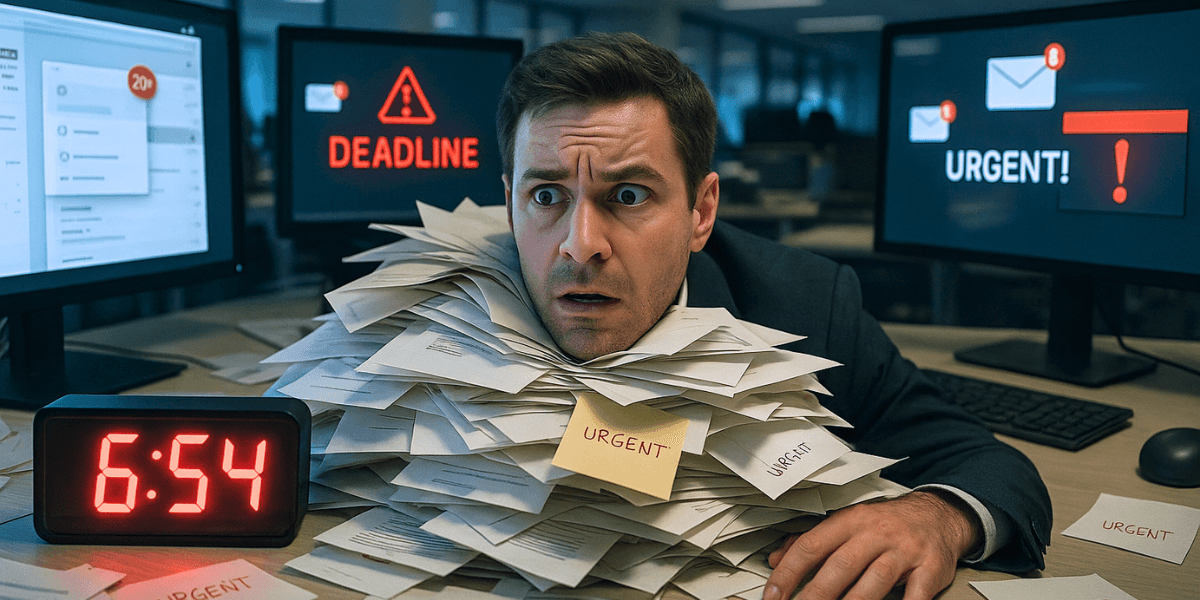Home > Workplace Stress: The (Truly) Effective Strategies
You feel it every morning when you wake up, that knot in your stomach, that lingering fatigue, that constant sense of pressure. Workplace stress is not just a minor inconvenience anymore; it has become a daily reality for nearly one in two people in Switzerland. According to a recent study, 49% of employees report experiencing high levels of stress in their professional lives (lemonde.fr). Even more alarming: 34% of employees are showing signs of burnout, with 13% suffering from severe burnout (FRM). But here’s the good news, it’s not inevitable. There are proven, science-backed strategies to manage workplace stress and regain genuine balance. In this article, we’ll share techniques that truly work.

Before jumping into solutions, it’s essential to understand what’s really happening in your mind and body. Professional stress isn’t just about “being overwhelmed.” Workplace stress results from an imbalance between what is expected of you and the resources you have to meet those demands. Picture a scale: on one side, the expectations (tight deadlines, unrealistic goals, managerial pressure); on the other, your resources (time, skills, support). When the scale tips too far, your body activates its alarm system.
Not all stress is the same. First, there’s acute stress, the kind you feel before an important presentation: your heart races, your hands sweat, but it passes. It can even be helpful, giving you a quick boost. Then there’s chronic stress, the one that builds up day after day, week after week. That’s the real problem. Your body stays in “alert mode” constantly, as if you were being chased by a bear… except the bear is your overflowing inbox and back-to-back meetings.
And finally, there’s burnout, or professional exhaustion syndrome. The World Health Organization defines it as “a state of emotional exhaustion, loss of control, and reduced personal accomplishment at work”. It’s not just stress anymore, it’s the complete depletion of your physical and mental batteries.

How can you tell if you’re really stressed, or just going through a rough patch? Your body sends signals that you should never ignore. The symptoms of workplace stress affect three areas:
Physically, you might feel a constant fatigue that doesn’t go away, even after the weekend. Headaches become part of your routine, along with neck and shoulder tension. Some people develop digestive issues, heart palpitations, or recurring insomnia.
Emotionally and mentally, it’s more subtle but just as damaging. You may get irritated over small things, struggle to focus, or notice your memory failing. That knot in your stomach every Sunday evening before work? That’s a red flag.
Behaviorally, you might isolate yourself from colleagues, procrastinate even though that’s not your usual self, or compensate with alcohol, cigarettes, or food. These behavioral shifts are warning signs that people around you often notice before you do.
Burnout doesn’t happen overnight. It builds up gradually, sometimes over months or years. Three key dimensions: emotional exhaustion (you feel drained), depersonalization (you become cynical, people feel like objects), and a reduced sense of accomplishment (you feel like your work has no value).
Here are the seven warning signs to watch for : constant fatigue that doesn’t go away even with rest, a total loss of motivation to go to work (note: this isn’t the same as fear), ongoing sleep problems, increasing difficulty concentrating, constant irritability over minor issues, growing cynicism, and that crushing feeling that no matter what you do, it’s never enough.

Now that we’ve identified the symptoms, let’s look at where the problem really comes from. Understanding the causes of workplace stress is already half the journey toward finding a solution.
Let’s be honest, the main source of stress is often quite simple: you’re being asked to do too much. Too many tasks, too many meetings, too many emails, too many impossible deadlines. This constant time pressure keeps your stress response permanently active. Work overload combined with a lack of autonomy creates what’s called “job strain,” a particularly toxic form of professional tension.

A manager who doesn’t support you, never acknowledges your efforts, communicates poorly, or worse, micromanages, is another major source of stress. The need for recognition is fundamental to human motivation. When you give your all and no one notices, when encouragement is absent, your motivation collapses, and stress skyrockets.
This one is often overlooked, but the physical environment matters a lot. A noisy open space where you can’t focus, uncomfortable temperature, slow computer equipment, all these small irritations pile up and raise your overall stress level. It’s like having an annoying background noise you can never turn off.

Now let’s get practical: how can you effectively manage stress at work? Here are some proven techniques, not vague theories, but real tools you can start using today.
It may sound simple, but breathing is your most powerful weapon against stress. Why? Because it’s the only way to directly control your autonomic nervous system. The most effective method is cardiac coherence: inhale through your nose for 5 seconds, exhale through your mouth for 5 seconds, and repeat for 5 minutes. Do this three times a day (hence the “365 method”). Scientific studies show that this practice significantly reduces cortisol, the stress hormone.
You can also try the 4-7-8 technique when sudden anxiety hits: inhale for 4 seconds, hold your breath for 7 seconds, exhale for 8 seconds. It instantly calms the nervous system. The best part? You can do it discreetly at your desk, no one will even notice.

A large part of your stress probably comes from a sense of chaos and loss of control. The solution? Regain control through work organization. Start each day by listing your three absolute priorities. Not ten, not twenty. Three. The ones that, if accomplished, will make your day truly productive.
Use the Eisenhower Matrix to sort your tasks: urgent AND important (do it now), important but not urgent (schedule it), urgent but not important (delegate if possible), neither urgent nor important (drop it, yes, really). This simple framework helps you escape the tyranny of constant urgency (Oxwork, 2023).
And please, stop multitasking. It’s a myth, the human brain can’t truly do several things at once. When you try, you lose time, make more mistakes, and increase your stress. Focus on one task at a time, finish it, then move on to the next.
This is probably the hardest piece of advice to follow, but also one of the most freeing. You don’t have to accept every new task that’s thrown your way. When your plate is already full and someone asks for more, you have the right to say: “I understand this is important, but I’m currently working on X and Y, which are priorities. If I take this on as well, something else will have to wait. What should come first?”
This phrasing is powerful because it doesn’t say “no” abruptly, it shifts the responsibility of prioritization back to your colleague. Experts in stress management emphasize the importance of setting clear boundaries.

Your brain isn’t designed to stay focused for eight hours straight. After about 90 minutes of concentrated effort, your attention drops sharply. The solution? Take 5-minute micro-breaks every hour and a half. Stand up, walk around, look out the window, stretch a little.
These breaks aren’t wasted time, quite the opposite. They allow your brain to consolidate information, recharge, and come back sharper. Think of it like charging your phone: if you wait until it’s completely drained, it takes much longer to recharge than if you top it up regularly.
If I could give you just one piece of advice, it would be this: move. Physical exercise is probably the most powerful stress reliever that exists. Regular physical activity significantly lowers perceived stress levels. Why? Because exercise releases endorphins (the feel-good hormones) and burns cortisol (the stress hormone).
No need to run a marathon. A 30-minute brisk walk during your lunch break is already enough to make a real difference. Ideally, find an activity you genuinely enjoy, yoga, swimming, cycling, dancing… whatever works for you, as long as you do it regularly. Three times a week is the minimum threshold to start noticing real effects on your mood and stress resilience.

You can’t effectively manage stress if you’re not getting enough sleep, it’s that simple. Lack of sleep makes your brain more vulnerable to stress, reduces your ability to regulate emotions, and weakens your immune system.
Aim for 7 to 8 hours of sleep per night. Create a bedtime routine: turn off screens at least one hour before bed (blue light disrupts melatonin production), keep your bedroom cool and dark, and avoid caffeine after 3 p.m. If you struggle to fall asleep because your mind is spinning with work thoughts, try writing them down on paper before bed. It gets them out of your head and helps you let go.
One of the biggest challenges today, especially with the widespread shift to remote work, is that the boundary between professional and personal life has blurred. Your office is in your living room, you check emails on the couch in the evening, you reply to work messages over the weekend… and your brain never truly disconnects.
Since 2017 in France (and Switzerland follows similar principles), employees have a legal right to disconnect. In practical terms, this means you are not obliged to respond to work-related messages outside of your working hours. Put it into practice: turn off notifications from work apps after 6 p.m. (or whenever your day ends). Don’t check emails in the evening or on weekends.
I know what you’re thinking, “Yes, but my boss sends me emails on Saturdays.” Let them. You don’t have to read them right away. You can even set up an automatic out-of-office reply that clearly states your working hours. HR experts recommend encouraging employees to take time off and promoting disconnection as a healthy and productive practice.
When you used to physically leave the office to go home, the commute naturally created a mental transition. With remote work, that boundary has vanished. Recreate it intentionally. At the end of your workday, establish a simple ritual: close your laptop, tidy your workspace, change clothes, or go for a 10-minute walk outside. This tells your brain, “Workday’s over, it’s time to switch off.”

Sometimes, despite your best efforts, stress becomes too heavy to handle alone, and that’s perfectly normal. Asking for help isn’t a sign of weakness; it’s a sign of intelligence and self-awareness.
Start with your general practitioner. They can assess your situation, prescribe sick leave if needed, and guide you toward the right resources. You can also reach out to your company’s occupational health physician, it’s free and confidential.
For psychological support, cognitive behavioral therapy (CBT) has proven highly effective for managing stress and preventing burnout. A psychologist or psychiatrist can help you identify negative thought patterns and develop healthier coping strategies. Online therapy is also a convenient option if you’re short on time.
A company that truly cares about employee well-being implements concrete actions: regularly assessing psychosocial risks, training managers in empathetic and participative leadership, offering stress management courses, ensuring a balanced workload, recognizing achievements, and providing autonomy and flexibility in work organization.
If this article has helped you better understand your work-related stress, imagine what you could achieve with structured guidance. Our “Optimize your stress management” training gives you practical, immediately applicable tools to transform your relationship with workplace stress. In just a few sessions, you’ll master advanced breathing techniques, learn to reframe negative thoughts, and build lasting resilience against daily pressure. More than a theoretical course, it’s a true mental fitness program to regain calm and performance at work. Don’t let stress run your professional life any longer.

Workplace stress isn’t a fate you have to silently endure. You now have a complete toolbox to take back control. Remember the key pillars: recognize the symptoms without downplaying them, understand the causes to act on them, apply practical techniques like breathing and organization, set clear boundaries between work and personal life, and seek help when needed.
Start small. You’re not going to change everything overnight, and that’s perfectly fine. Choose one or two techniques from this article and apply them this week. Maybe it’s practicing cardiac coherence three times a day, or getting into the habit of listing your top three priorities every morning. Then, gradually add other strategies. What matters most is taking action now, before stress turns into exhaustion.
And above all, be kind to yourself. You’re doing your best in a work culture that constantly asks for more. Taking care of your mental health isn’t selfish, it’s smart. You can’t achieve anything lasting if you burn out along the way. So breathe, set boundaries, ask for help when needed, and remember: you are worth far more than your productivity.

How can I tell if my work stress is “normal” or unhealthy?
Feeling stressed before a deadline is normal. However, if you experience constant anxiety, fatigue that doesn’t go away, ongoing physical symptoms, or a complete loss of enjoyment at work, consult your doctor. Don’t wait until you’re completely drained.
Can I get in trouble for telling my employer I’m stressed?
Legally, your employer cannot fire you for expressing distress. Keep your approach factual: list specific issues and suggest realistic solutions. If you’re worried about their reaction, talk to your occupational health doctor or HR department instead.
How long does it take to recover from burnout?
It depends on the severity. In mild cases, a few weeks to a few months may be enough. For severe burnout, recovery can take 6 months to 2 years. The key is not to return to work too soon to avoid relapse. A gradual reintegration is strongly recommended.
Do breathing techniques really work?
Yes,it’s scientifically proven. Cardiac coherence measurably lowers cortisol levels. Breathing directly regulates your autonomic nervous system. However, like any skill, it takes regular practice to see lasting results.
Should I quit if my company does nothing to improve the situation?
If your health is seriously deteriorating and the company ignores your repeated warnings, leaving may become necessary. Before resigning, explore other options: internal transfer, mutual termination, or medical leave. Consult a labor law specialist if needed.

ITTA is the leader in IT training and project management solutions and services in French-speaking Switzerland.
Our latest posts
Subscribe to the newsletter

Nous utilisons des cookies afin de vous garantir une expérience de navigation fluide, agréable et entièrement sécurisée sur notre site. Ces cookies nous permettent d’analyser et d’améliorer nos services en continu, afin de mieux répondre à vos attentes.
Monday to Friday
8:30 AM to 6:00 PM
Tel. 058 307 73 00
ITTA
Route des jeunes 35
1227 Carouge, Suisse
Monday to Friday, from 8:30 am to 06:00 pm.